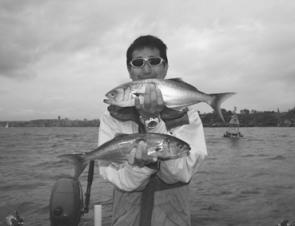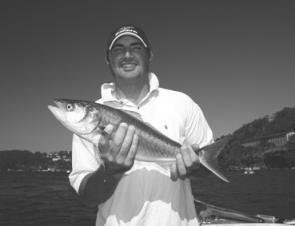Things have really fired up in the Harbour on the pelagic front over the past few weeks.
Kings have been in good numbers and of a much better average size than I can remember for years. Salmon and tailor have come up on top and are thick around Clifton Gardens and Balmoral.
The only thing we need to complete the list is bonito and reports from the north indicate that they are on their way. Here’s a few tips for getting into them with lures.
Trolling lures is a great way of finding some species. It works exceptionally well on bonito, tailor and spotted mackerel. Its only average on salmon, striped tuna, mackerel tuna, frigate mackerel and trevally. Its success rate on kingies is poor.
Trolling is best done with minnow-style lures. Metal baitfish profiles and skirted lures the likes of Christmas trees are good when the fish are high up in the water. Those types of lures will ride high at the trolling speeds required for pelagics (4 to 8 knots).
Minnows offer deep-diving capabilities or at least reliable depth control. My favourites are Rapala CD7s and CD9s and Producer Lures Barra Mauler No 4 and No 5 after you’ve upgraded the Producers’ hooks.
A trolling pattern must be established to locate the concentrations of fish. This usually involves a close run first and then moving a little bit wider on each run after that.
Troll in both directions on each run because it’s common to find fish biting in one direction and not the other. Keep an eye on your sounder for baitfish concentrations, on other boats trolling to see where and what they are catching and so you don't run into them, on birds working the surface, on current lines and, most importantly, on gnarly waves, bommies and other navigation hazards.
Most people I know would rather cast to pelagic fish than troll for them. What do you do, though, if you want to cast a lure or fly to pelagics but can't visually or electronically find them? Troll until you find them and then cast.
Elitist fly anglers who refuse to carry conventional gear on principle are doing themselves a disservice in this respect. Trolling is a legitimate fish finding tool, even if you do not like or intend to catch them this way.
When the time comes to approach the school there are a few things to keep in mind. Don't charge right up to, and never into, the feeding school as this will almost certainly put the fish down.
There are exceptions to this, where a rapid approach is essential. Certain species will, at times, feed in very short bursts and if you are not there quickly you will miss your shot. You must approach fast but keep your distance. The obvious distance to pull up is at the extremities of your personal casting range.
You must consider your boat shadow as this will put fear into your school long before the engine noise. Shadows are the early-warning signs of large predators where engine noise is unfamiliar and fish have proven to be to be far more wary of dangers that they are familiar with.
The basic rule is to never get between the sun and the fish. The lower the sun in the sky, the more this applies.
Try to anticipate the direction that the fish are moving and be sure not to put your boat in their path. In windy conditions you can use the wind to make a quiet approach on a school but position your drift to take you alongside the school and not over the top of it.
Never assume that the fish you are seeing on the top are necessarily those you are catching. It is common for fish of different species to ‘layer’ – such as salmon on top, bonito under them and trevally under them.
Your first few casts should be retrieved immediately but later casts should be allowed to sink to varying depths before the retrieve. Many pleasant surprises have come from this technique.
Silver trevally rarely feed right on top but are quite common below Winter salmon. They will take lures at these times, often on the fall.
Kings are regulars below tailor and bonito. The first sign of them is when one follows a hooked tailor or bonito to the boat.
Kingies are the easiest of all the pelagics to locate but usually the hardest to catch. Their biggest downfall is their love of shade but to some extent its also their saviour.
Structure creates shade. Structure is very easy for us to locate but it also gives the kings something to wrap us around. They will face into the current when they are holding
Avoid lures that rattle for kingies and that includes anything with trebles and split rings. The Slug-Go is No1 but you will occasionally get away with poppers as the splashing sound helps mask the rattling of the hooks and rings.
Although most of the pelagics make much better table fish than they are credited for, they are primarily sought as sport fish. I don't intend to outline recipes or preparation of individual species but there are a few golden rules for pelagics if they are to be kept for the table.
• Bleed, gut, gill and ice these fish as soon as possible.
• Fillet and skin the fish just before you intend to cook them.
• Most pelagics don't freeze well although trevally, kingfish amberjack and samson are OK for a few months.
• Species that don't cook up to well probably will be good sashimi, such as frigate mackerel, striped tuna and mackerel tuna.
• Fillets are best cooked as you would a rare steak. Overcooking will dry them out.
• Australian salmon are the exception and fully deserve their reputation as revolting!
Reads: 1470
Kingies are the easiest of all the pelagics to locate but usually the hardest to catch.

Providing they are bled, gutted, gilled and iced down as soon as possible, tailor are quite tasty when eaten fresh, especially if they’re hot-smoked.

They fight like demons and salmon would have a reputation as an iconic Australian fish if only they tasted a little better.




